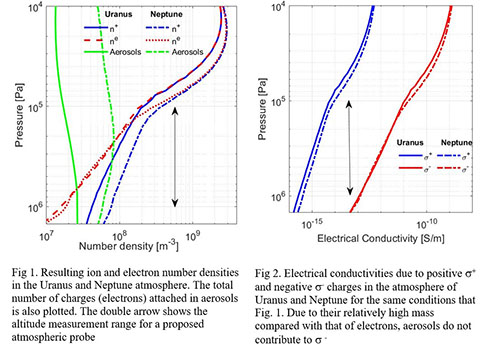Modelling of the Electrical Conductivities in the Atmosphere of Ice Giants
- 1Dept. Electromagnetism and Electronic, University of Murcia, Murcia, Spain (gregomc@um.es)
- 2European Space Agency, ESA/ESTEC, Directorate of Science, Noordwijk, Netherlands (owitasse@cosmos.esa.int)
- 3Laboratoire Atmosphères, Milieux, Observations Spatiales, Guyancourt, France (franck.montmessin@latmos.ipsl.fr)
- 4Laboratoire Atmosphères, Milieux, Observations Spatiales, Guyancourt, France (jean-jacques.berthelier@latmos.ipsl.fr)
Many studies were carried out recently regarding the exploration of Ice Giants, in the context of the next NASA decadal survey in planetary sciences and astrobiology, of the next planning cycle in ESA's Science Programme, and of a possible NASA-ESA collaboration. A mission to an Ice Giant could include an atmospheric probe, to operate in the 1-10 bars pressure range. Its payload could comprise sensor(s) devoted to the measurement of electrical properties, plasma densities and conductivities.
In order to check the performances of such instruments, it is necessary to develop models of the electron and ion densities profiles, with and without aerosols, from which the electrical conductivities can be derived.
A model was developed based on studies performed at Mars and Titan [1-2], which computes the atmospheric positive and negative electrical conductivities between 0.1 and 15 bars in the atmosphere of Neptune and Uranus. In this altitude range, galactic cosmic rays ionize the atmospheric constituents, which react with atmospheric neutrals and aerosols, leading to the formation of ions heavier than the ones produced by cosmic rays. The densities of positive ions, electrons and charged aerosols are obtained by solving their corresponding continuity equations. It has been found that aerosol particles tend to be negatively charged due to the attachment of electrons, as a more efficient process than the attachment of positive ions. Therefore, the electrical conductivity due to negative charges is strongly reduced compared to the one expected when aerosols are not present. However, the electrical conductivity due to positive ions does not change so dramatically. The experimental determination of both components of the electrical conductivity can be useful to understand the properties of aerosols, plasma and electric currents in the atmospheres of Ice Giants.
Figure 1 and 2 shows some the first results of the number density and electrical conductivities in the atmospheres of Uranus and Neptune. They were calculated for a cosmic rays flux valid for a heliocentric potential of 100 MV, neglecting the planetary internal magnetic field, a mean ion mass of 100 amu and the aerosol particle distribution reported by Toledo et al. [3-4], which is extended down to the pressure range here considered.

References
[1] Cardnell, S., et al. (2016), A photochemical model of the dust-loaded ionosphere of Mars, J. Geophys. Res. Planets, 121, doi:10.1002/2016JE005077.
[2] Molina-Cuberos, G.J., et al. (2018) Aerosols: The key to understanding Titan's lower ionosphere, Planet. Space Sci, 153, 157 – 162, doi: 10.1016/j.pss.2018.02.007.
[3] Toledo et al. (2019), Constraints on Uranus's haze structure, formation and transport, Icarus 0019-1035, doi: 10.1016/j.icarus.2019.05.018
[4] Toledo et al. (2020) Constraints on Neptune’s haze structure and formation from VLT observations in the H-band, Icarus, doi: 10.1016/j.icarus.2020.113808
How to cite: Molina-Cuberos, G. J., Witasse, O., Montmessin, F., and Berthelier, J.-J.: Modelling of the Electrical Conductivities in the Atmosphere of Ice Giants, Europlanet Science Congress 2020, online, 21 September–9 Oct 2020, EPSC2020-523, https://doi.org/10.5194/epsc2020-523, 2020